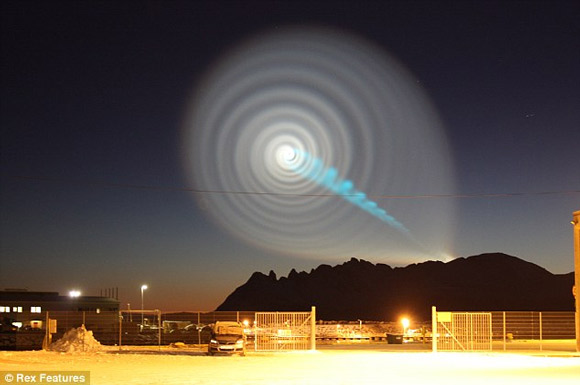Some may have thought it was a prelude to a close encounter of the third kind. But evidence quickly emerged that it was probably a result of a Russian ballistic missile test.

While almost everyone who saw the video of a luminous spiral of gas in Norway at dawn on Wednesday agreed it was beautiful, UFO believers have staunchly held to their views that the phenomenon was not man made, even after Russia's Defense Ministry disclosed it had test launched a Bulava ballistic missile – which has a range of 5,000 miles – from a submarine in the White Sea Wednesday morning. The Russians said problems emerged when the missile improperly deployed its crucial third stage engine and it went off course and out of control.
| Technical Note: The Bulava (SS-NX-30) is the submarine-launched version of Russia’s most advanced missile, the Topol-M (SS-27) solid fuel ICBM. The SS-NX-30 is a derivative of the SS-27, except for a slight decrease in range due to conversion of the design for submarine launch from below surface. The SS-27 is 21.9 meters long, far too large to fit in a typical Russian (or U.S.) submarine design. The largest previously deployed Russian SLBM was the R-39 / SS-N-20 STURGEON, which was 16 meters long. Russian sources report that the Bulava SS-N-30 ballistic missile can carry up to ten warheads to a range of 8,000 kilometers. Other sources suggest that the Bulava may have a maximum range of 10,000 kilometers, delivering adjustable-yield advanced nuclear warheads that can be pre-selected before launch to yield from 120 kT to 550 kT maximum, each. Six nuclear terminal delivery devices are standard for the design, but ten smaller MIRVs using designs from the U.S. W-88 systems can be placed in the payload delivery system at the cost of offloading warhead electronic frequency shielding and decoy deployment systems to defeat current US Space Command defensive countermeasures. |
The Russian explanation makes the most sense to William Dimpfl, a senior research scientist at the Aeorospace Corporation.

Dr. Dimpfl, whose non-profit conducts missile research for the US Air Force and NASA, and who has carried out research on the way exhaust is emitted from rockets and the space shuttle, says he's fully convinced that the spiral plume was caused by a man-made missile.
"I looked at the video and my first thought was it’s surprising how pretty it is," says Dimpfl. "But I had an understanding very quickly of what was going on. There’s nothing surprising in (the video)."
Dimpfl says he doesn't have inside knowledge of Russian missile testing protocols, but estimates that the Russian plan was for the missile to splash down in the Pacific Ocean. He says that when the US conducts missile tests it also tries to ensure that the missile will splash down in the ocean if something goes wrong and it falls short.
He said after watching the video that he observed no "atmospheric drag" on the event, which implied the missile was higher than 100 kilometers from the earth's surface – beyond the line between our atmosphere and space. The large, white spiral in the video and images is, in his opinion, "an illuminated solid propellent motor." The spiral, he says, "comes when you have a motor firing off the axis of the vehicle at right angles to the line that connects to the center of mass" yielding a "pinwheel."
As to the tighter, bluish covered spiral that UFO believers have pointed to, he says: "The blue plume was from a motor that was still attached to the vehicle." He says the bluish color was from aluminum oxide that is typically added to the solid propellant used for such motors. "What I believe is that the blue is from solar fluorescence from chemicals in the plume. That’s just aluminium oxide that the sunlight is scattering from. Aluminum oxide is the chemical formula for sapphires, so what you’re looking at is sunlight scattering off lots of tiny sapphires."

|